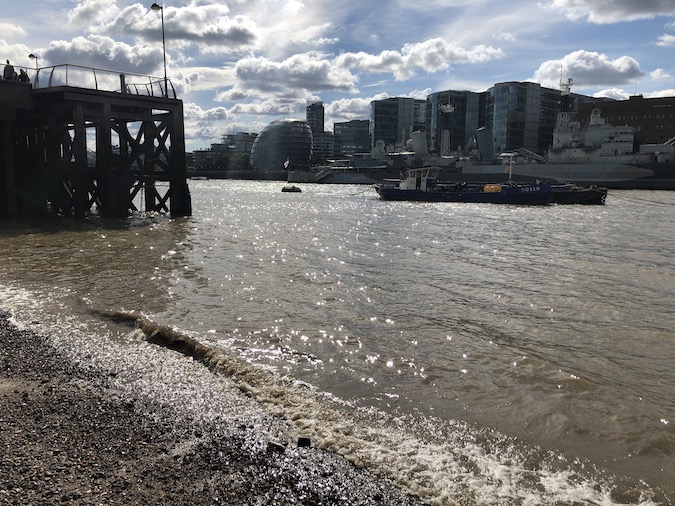A scene from my soon-to-be-published novel – more details to follow – is set on the small piece of beach, if that’s the right word, you can see from Old Billingsgate Walk as shown in the photo above. Beyond that gravely spot stands Sugar Quay Jetty, a structure designed by Sir Terry Farrell to accompany his mid-1970s office building for sugar refining giants Tate & Lyle at Sugar Quay.
The offices have now gone, replaced in 2018 by the deluxe residential Landmark Place, with its cinema room, business suite and 20 metre pool. But there is still a Sugar Quay Walk and the jetty is now a public space jutting out into the Thames, whose waters lap beneath. My characters can make out its underside as they whisper in the dark below Custom House Walkway.
Why set a fictional scene there? I have a handful of reasons. They include the proximity of Tower Bridge, the views across the water of HMS Belfast, Sir Norman Foster’s now former City Hall and the Shard, and the intermittent availability of the patch for standing on: as the Mapcarta map below indicates, it gets covered in water when the tide is in.

I like that as a sort of metaphor for changeability through London history. I might also have liked the wider location as a symbol of empire and exploitation, sugar cane having been produced on slave plantations, but I didn’t know the name Sugar Quay until yesterday.
This riverside spot, as you would expect, has a long, long history. Volume 15 of the Survey of London, published by the London County Council in 1934, is the place to read it. The survey tells us that Sugar Quay was once called Custom House Quay and before that Wool Quay, a name attached to it from probably at least 1275, when duties began to be collected on exported wool.
For a time it was known as Baudrie’s Wharf and during the 1330s and 1340s belonged to a woman called Petronella Turk, of whom little is known except that she appears to have been wealthy. In 1374 a certain Geoffrey Chaucer was appointed controller of customs in the Port of London, meaning he oversaw the collection of duties on wool, along with wine, cloth and other goods.

A new custom house building was erected the early 1380s and replaced by another in 1559. This was destroyed by the Great Fire of 1666. Christopher Wren designed another one. The Survey describes it as “one of his most perfect buildings”, but its tenure too was ended by fire within 50 years after a nearby house where gun powder was stored blew up. Board of Customs “master carpenter”
Thomas Ripley was the architect of the next one, which lasted until 1840 when it too was burned out, just four months after yet another successor was completed right next door. A resulting explosion – gunpowder again – “scattered multitudes of customs papers far over the metropolis, so that later they were brought back from as far away as Hackney Marshes,” the survey says.
That was the end of the link with the customs service and with wool. A steamship company moved in. Terry Farrell would follow and much of the rest we know. Has that little patch of pebbles, stones and gravel been disappearing from sight and reappearing again all that time? I do not know. But, in a small way, it is soon to be immortalised.
Follow John Vane on Twitter.
On London strives to provide more of the kind of writing the capital city needs. Become a supporter for just £5 a month. You will even get things for your money. Learn more here.

